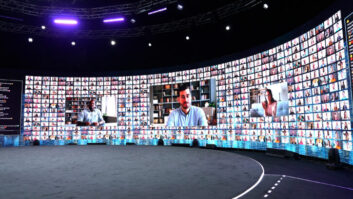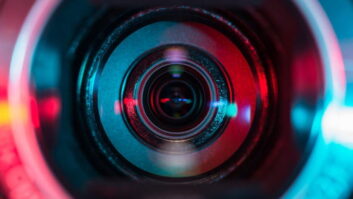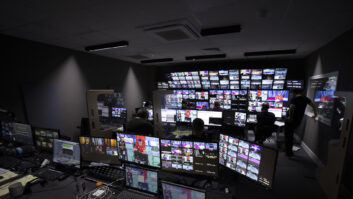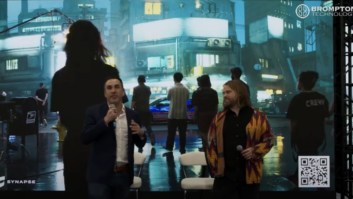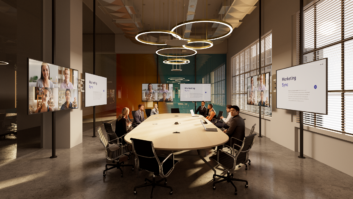The topic of convergence between technologies traditionally associated with pro AV and broadcast, respectively, has been much-discussed in recent years – not least in the pages of Installation and its sister publication, TVBEurope. Indeed, the two titles are joining forces again for a special eBook on the subject. And with another edition of IBC approaching, it seems a timely moment to assess what we might term the “continuing adventures of convergence”.
Having spoken to more than half a dozen leading vendors and specialists with interests in both broadcast and pro AV, there’s no doubt that the merger is ongoing – in fact, it seems to be accelerating. The preponderance of new solutions being introduced in 2024 that are being marketed jointly at both markets is just one factor that suggests a new phase of maturity is now shaping the convergence trend.
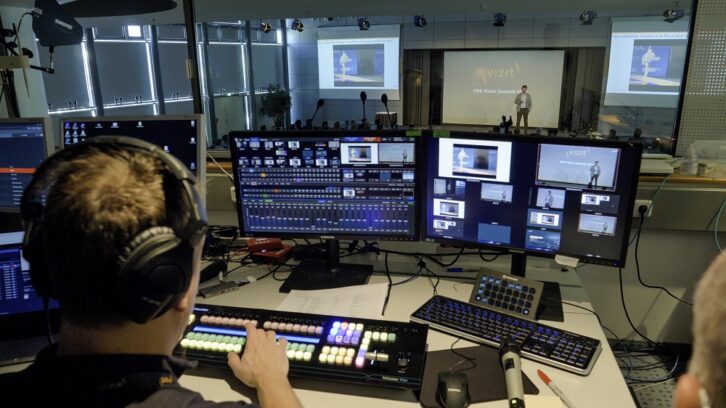
DRIVE FACTORS
In this in-depth article, we’ll look at the factors driving the convergence; the verticals where it is most advanced, and where it is likely to occur next; the specific technologies that are driving the convergence; the impact of all these developments on R&D; and the pro AV prospects for virtual production, XR and other technologies currently growing in the media environment.
Whilst the previous paragraph alludes to factors – plural – behind the convergence, the reality is that there is one element above all driving it: the need for higher-quality content for participants and viewers, whether they are located on-site or remotely, and the ability to produce and deliver this with the utmost flexibility. And if the pandemic was the initial spur to action, the ensuing era of hybrid working has only solidified the need to access high-quality production equipment.
REMOTE CONTENT
Graham Payne is product marketing manager, ITCG marketing and product management, at Canon UK & Ireland, which has seen particular growth in pro AV of PTZ cameras. “Since the pandemic we have seen a huge demand for high-level remote content in many walks of life – education, corporate and healthcare, plus many more. Many places that never had a need to stream remotely suddenly saw an opportunity to do so and saw the massive benefit of it. Most started with any camera they could get their hands on, but remote content streaming and content is here to stay, and the demand to improve the output is there.”
Matt Morgan is business development manager, corporate at Ross Video, and agrees with the suggestion that the pandemic made the convergence happen more quickly than might otherwise have been the case. “There were so many stories we heard during that period of an executive being on a broadcast using their mobile device, and [for one reason or another] it not representing the company well and it feeling like a ‘miss’,” he recalls.
“I think one result of that is that organisations didn’t want that happening again, and instead wanted the ability to really handle the quality of what’s going in and out – which is audio and video, and leveraging [high-quality] solutions.” Simultaneously, it became even more evident that “having engaging content is really important, and all of these things have come together – and the pandemic definitely spun up a lot of that”.
HUGE DEMAND
Abe Abt, senior product consultant at AJA Video Systems, also indicates a demand for more flexibility and control of video workflows, along with a surge in requirements for the kind of low-latency routinely needed in broadcast. “The events of 2020, and the years that followed, created a huge demand for remote workflows, whether attending meetings from home, facilitating a class lecture or HoW [house of worship] service virtually, or working collaboratively with a remote production crew to maintain a safe distance,” he says. “These applications require similar, high-quality, low-latency video technology. It’s the kind of demand that helps spur innovation, and has helped drive our efforts to exponentially improve how data and media are shared over long distances in a very short time.”
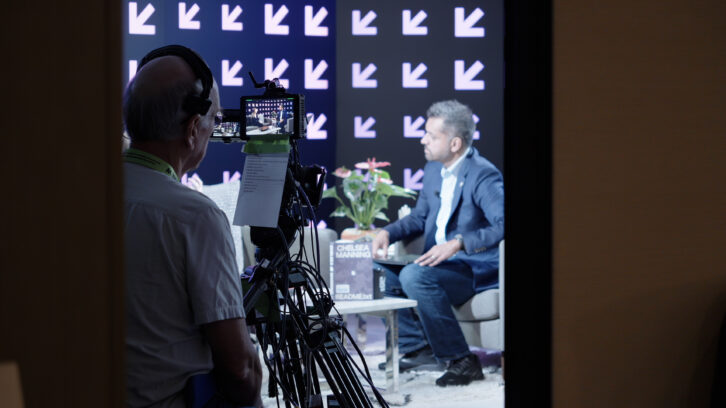
Dave MacKinnon, vice-president of product management at Clear-Com, comments that the company’s FreeSpeak digital wireless and Arcadia IP intercom solutions are performing strongly in both broadcast and pro AV. “The standardisation required for IP and cloud-based communication has driven a lot of the convergence between our market segments,” he explains. “We’re also seeing customers who are looking for highly integrated solutions that handle the greater part of their workflow.”
He also indicates that the convergence should not be perceived as coming from one direction only. “What’s been interesting is that pro AV has influenced broadcast as much as broadcast has influenced pro AV,” he says. “The Covid pandemic and work from home accelerated a lot of these transitions, and the post-Covid economic fallout has made customers more price-sensitive and looking for greater capability in the solutions that they’re buying.”
VERTICAL ADVANCES
There is also significant consensus about the pro AV verticals where the convergence is most advanced, namely education, HoW, live venues (especially for sports) and corporate, which is also the subject of a virtual production-focused feature elsewhere in this issue. All four share an acute need for smooth production and high-quality content.
As Payne notes: “We see in many universities and colleges a demand to deliver a high-quality remote learning platform. We also see many businesses producing high-quality content for remote and hybrid workers, [whilst there has been] a boom in HoW where the reach can increase with remote content.”
Claus Pfeifer is head of connected content acquisition at Sony Professional Solutions Europe. “The biggest overlaps we see are in corporate and education,” he says, adding that in the case of corporate “more organisations are requesting to have high-quality video, so they are using the tools widely available. That’s not only cameras, but also production tools [with a view to] streaming directly to their employees and creating high-quality content. And we see the same [pattern] in education, too”.
Abt says corporate AV has seen much more use of broadcast technology in recent years, simply due to the advent of IP video. “Be it compressed IP formats like NDI, Dante AV, JPEG XS, or uncompressed SMPTE 2110 video, the broadcast and corporate AV worlds are sharing this incredible technology,” he argues. “[In addition] the advent of remote work in the pro AV world and REMI (remote production) in broadcast have led to both sharing encode/decode and streaming technology to allow teams to work together more collaboratively from remote locations.”
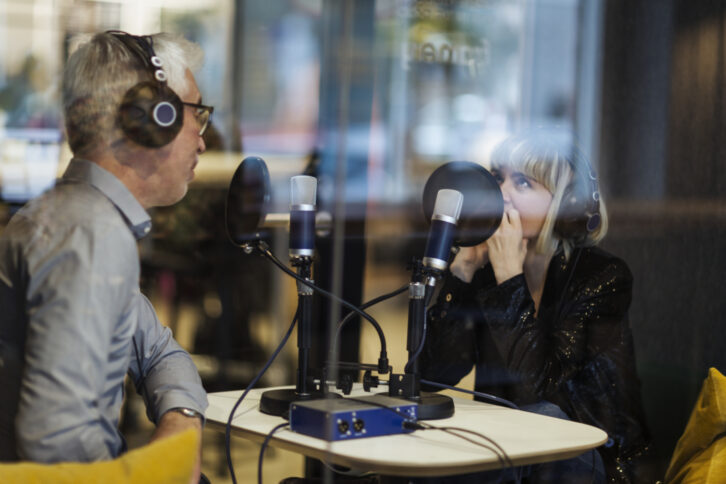
For Ross Video, Morgan is very well-positioned to comment on the extent of the convergence having previously worked in government and corporate AV installation, as well as a broadcast engineer at some of the largest churches in the US. Of the latter vertical, he says that “for years and years, there has been this need for video to drive engagement with churches and congregations”.
As far back as 2006, “you had some of the churches really starting to pick up on new video transport solutions. [For example] there might be a church doing a wide shot of a stage and projecting that back on a giant screen so that it appeared the communicator was standing on-stage, and then they had the live IMAG screen showing the IMAG cut. They were doing this kind of different style of video that no one else was really doing”.
CHURCH CONCERTS
If the circumstances for convergence in HoW were established early on, then they have become even more pronounced as the number of multi-site churches has exploded. Morgan: “The church I worked at was up to about 35 campuses across 11 states when I left. More than ever, churches have ongoing weekly services that are online and in person, and they may also be booked out for concerts and other entertainment venues, and at the core of all that they require a video infrastructure is really solid”.
Large venues – in particular, for sports – are identified as a target of convergence by Imagine Communications president Steve Reynolds. “For the big stadiums that are moving a lot of video around to suites, luxury boxes, in-venue video screens and even some of the in-venue replay stuff, we’ve definitely seen a move towards IP there, especially SMPTE ST-2110 applications,” he says, noting that Imagine’s Selenio Network Processor is often its “core solution” in IP production.
Blackmagic Design director Stuart Ashton also points to greater demand for broadcast-grade technology in live events. “Traditionally, we’ve seen Blackmagic’s broadcast video technology incorporated and utilised in rental and staging applications – typically covering sports, live performances or staged events with video content used to provide a richer audience experience at the show,” he says, citing a recent project that saw Chicago-based production company Media Stream Wave use a Blackmagic Design workflow comprised of 40 Blackmagic URSA Broadcast G2 cameras, 14 Atem Constellation 8K live production switchers and more as part of its work for the 2024 Coachella and Stagecoach music festivals, produced by Springboard Productions.
MULTIPLE MARKETS
With the same solutions increasingly catering to multiple markets and verticals, it seemed logical to ask our interviewees what impact the convergence is having on the R&D process – and which considerations are being prioritised as a result. Flexibility of connectivity and network control, it transpires, are fairly universal requirements.
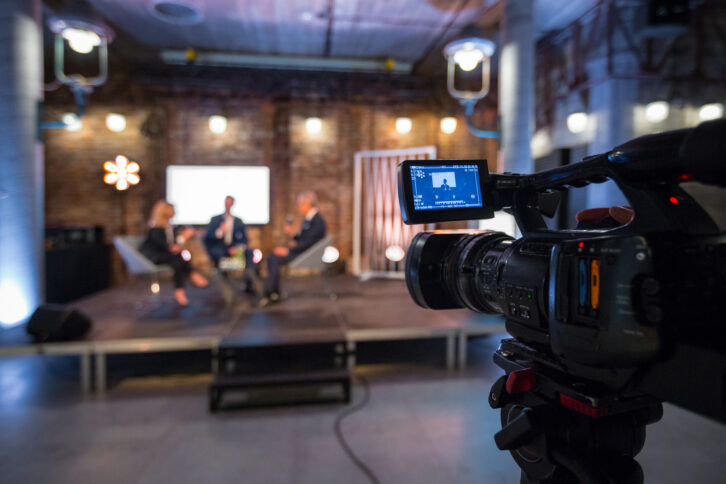
Alun Fryer, technical marketing lead, hyperconverged solutions, at Ross Video, cites a recent example involving its Ultrix routing, multiviewer and signal processing platform. “There is a great deal of listening to our customers through our business development and sales channels,” he comments. “For instance, this year we announced [native support for] Dante networking technology, and the immediate response to that was jubilation. Customers were coming up to me throughout [NAB 2024] to say ‘thanks, this is exactly what we need’.”
With networking in pro AV – and broadcast, for that matter – remaining pretty diverse, the ability to support different protocols is likely to be an ongoing focus of vendor R&D (Ross Video also recently unveiled further adoption of NDI technology across its portfolio). In addition, general ease of control and everyday usage continue to linger at the top of the priority list.
“A major part of it is looking at how people are integrating [different solutions] and the whole control aspect, because depending on the sort of verticals and spaces you’re in, there may be different types of operator and different [approaches],” adds Fryer. “For example, in some churches [AV might be run] by volunteers and not necessarily trained broadcast professionals. So you have to ensure that systems are very easy to use, [including through] the design of user interfaces.”
VERSATILE STREAMING
Liam Hayter is product manager at content production and management specialist Vizrt, which in 2019 acquired NewTek – the company that originally spearheaded the development of NDI. He notes that this technology is “one of the few” that straddles broadcast, pro AV and telecommunications. “We were fortunate in that [we had] a lot of foresight as to where things would go once streaming emerged and there was [a greater move towards] computers as production tools,” he says. Schools and colleges are among the environments to have leveraged NDI as a way of creating versatile “AV and streaming experiences, [and] we don’t see any side of that slowing down”.
Indeed, June 2024 saw Vizrt launching what is billed as the first native NDI Bridge multi-channel video conversion tool. Viz Connect Tetra is designed to simplify remote, local and hybrid content creation with four 4K I/O channels integrating HTML 5, NDI, NDI Bridge, and 12G SDI conversion in a portable workstation.
Given all of the above, it’s not surprising that manufacturers of connectivity and conversion solutions are among those finding the convergence to be fertile territory. Provision for SDI and IP workflows, with support for 4K/UHD if needed, seems to be a particular focus.
DIGITAL GLUE
For AJA, Abe Abt highlights the success of the company’s BRIDGE LIVE broadcast quality, low-latency IP video workflow bridge, and BRIDGE NDI 3G 1RU gateway, which offers high-density conversion from 3G-SDI to NDI and NDI to 3G-SDI for both multi-channel HD and 4K/UHD: “While AJA has always offered a huge range of conversion products that help both the broadcast and pro AV markets (often dubbed ‘digital glue’ by our customers), the growing convergence of the two markets has allowed both to share some of our bigger and more feature-rich products. Our BRIDGE LIVE and BRIDGE NDI 3G products are huge in corporate AV, education and broadcast due to their ability to seamlessly bridge multiple baseband and streaming/IP video formats. The use cases across both markets are endless.”
For Blackmagic Design, Ashton cites the IP10 codec, which is part of its 2110 IP converter range that is designed to integrate SDI equipment into 2110 IP broadcast systems for customers in broadcast, pro AV and live production.
“The shift towards IP is a significant focus, drawing attention due to its potential to transform production workflows,” he says. “However, adoption is met with apprehension. Customers question how to integrate IP effectively without disrupting existing setups, and they are concerned about the implications for content quality and the required investments. [The IP10] aims to address these concerns, offering a plug-and-play solution that simplifies the transition to IP. It’s designed to be affordable and scalable and requires minimal IT knowledge, enabling seamless integration into existing workflows with virtually no latency for UHD 60fps content.”
Looking ahead to what technologies and formats might be embraced by pro AV next, several contributors point to a likely upward trajectory for HDR (high dynamic range), which is already used widely across TV and film to improve image detail. “Who doesn’t love pretty pictures?” notes Abt. “Both the broadcast and pro AV communities, and their audiences want to see sharper images and more vibrant and beautiful colours, and they want to see these on everything from tiny phone screens to massive LED walls. AJA develops a myriad of technologies to support HDR, 4K, 8K and beyond, and we look forward to continuing to support our customers as they embrace these technologies in the future.”
MORE COMMON
For Sony, Pfeifer says that the use of S-Log – a log curve that has been specially optimised for digital cameras to maximise the performance of the image sensor – to create high dynamic range content “is getting to be the norm [even for] not so experienced content creators. Working in HDR and 4K is becoming more and more common”.
In terms of specific Sony products resonating with the broadcast/pro AV convergence, he highlights the HXC-FZ90 Studio Camera System – “a cost-effective solution that can easily be used in a corporate studio” – as well as various PTZ cameras and the XVS-G1 video switcher, designed in the tradition of a Sony vision mixer “but at the same time using technologies come from the graphics or gaming industries to [offer] the best of both worlds”. With these kind of solutions, Pfeifer believes, “it is relatively easy [to build] a corporate studio that can be used for live-streaming or presentations”.
CLOUD POTENTIAL
Reinforcing the sense that convergence between broadcast and pro AV is accelerating, there is also a general expectation that cloud – still a relatively new aspect of broadcast production workflows – will also begin to see significant traction in some AV verticals in the near future.
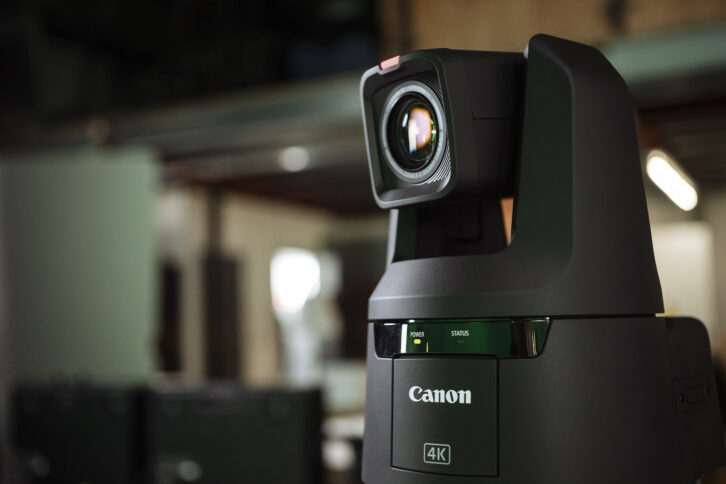
“Cloud is going to be huge,” predicts MacKinnon. “As the first company in our segment to build a hybrid cloud and on-premise intercom solution, I think we’re well-positioned to take advantage of the coming trend. Customers are looking for flexibility and scalability, and we can deliver that in wired and wireless solutions in the cloud, or on-premises.”
Much of this is line with a broader migration towards software-driven solutions – and related shift in budgetary emphasis away from hardware – that is only intensifying. In general, says Reynolds, users are now “a lot more comfortable with running things in a software-based environment. We primarily now build all of our GUIs as HMTL GUIs because people are comfortable with the idea of running it in a browser, iPad, or other tablet-type device”.
Consequently, he adds, “when we get RFIs or RFPs, there’s a lot less emphasis on hardware, and a lot more on the software, openness and APIs. Ten years ago nobody asked for a list of APIs in response to an RFI document, but now there [tends to be a] whole section talking about APIs, integration surfaces and so on.”
In many ways, then, pro AV is increasingly mirroring the use cases, preferred technologies, and operability expectations of broadcast. Whilst a short-term consequence of this could be a reduction in diversity among vendor offerings, in the longer-term the ability to concentrate and optimise R&D resources across markets could be hugely beneficial in freeing up funds that allow the development of entirely new technologies.
Something for which there is, currently, an unprecedented appetite for across broadcast and pro AV.
